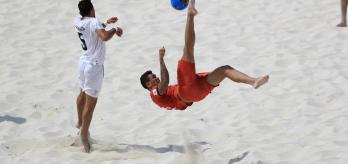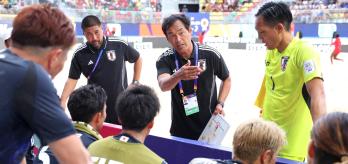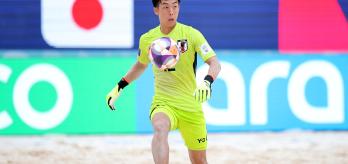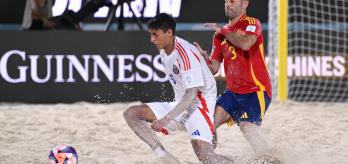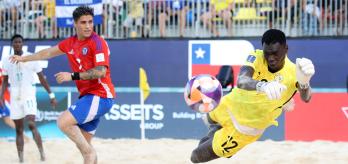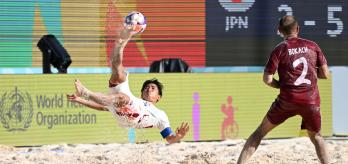In tight games, Angelo Schirinzi and Matteo Marrucci observed the that teams that managed these transitions best generally won. They also highlighted that the strongest teams had pre-planned strategies both to capitalise on opportunities to counter-attack and to deny such opportunities to their opposition when transitioning to defend and into the recovery phase.
Moreover, the TSG observed that the third (and final) period of games was the most transitional, and the data provided by our Football Performance Insights Team backs this up with an average of 201 counter-attacks occurring in this period compared to 130 in the first period and 135 in the second.
As Marrucci explains, “We see more transitions in the final period because teams are more tactical and strategic in the opening periods until the flow of the game emerges. By the third period, at least one team must make a move to try to win the game, so it becomes more open in this period. Often, one transition can lead to another transition. Also, team energy and player energy is conserved a little in the early periods, and generally teams will empty their reserves and really go for the game in the final period. This can lead to games becoming more transitional as fatigue sets in, but also teams can become more frantic and less predictable as the pace increases.”
Transitions to attack
The average number of passes per counter-attack during this tournament is just 1.3, indicating the speed and efficiency with which these moves are executed.
As Schirinzi explains, “Fast transitions are important because your opponent is mentally in attacking mode and there is going to be space open because they have committed players to attacking positions. Mentality-wise, going forward is easier than going back, and if a team can initiate a fast counter-attack when their opponent is disorganised they can find space and score, but it must be quick – in one or two passes maximum.”
With 28 games completed in the tournament so far, Portugal have generated the joint highest number of attempts at goal from counter-attacks (18) and have scored four goals, while Belarus have scored two goals from their 18 attempts at goal in this phase. Defending world champions Brazil are also extremely efficient in the counter-attacking phase, converting four of their 12 attempts at goal. Their conversion rate of 33.3% means they score an average of one in every three counter-attacks from which they produce an attempt at goal. The data shows they also generate an average of three attempts at goal per match from counter-attacks, meaning they score an average of one goal per game in this phase.
According to Schirinzi, “Even strong playing teams who dominate possession have strong counter-attack figures, because they have a plan for these moments of the game and also have key players with the technique and execution needed to capitalise on the space and opportunities when they arise.”
Below, Schirinzi highlights some excellent counter-attacking moments from the quarter-final matches. Clip 1 is from Brazil’s victory over Spain and starts with Spanish goalkeeper López (1) in possession of the ball. Brazil’s outfield players are man-marking, but as soon as López lifts the ball with his feet, Mauricinho (11) moves towards him from the right-wing position, disturbing his space and disrupting his timing to provoke a bad pass. The coordination of the press from Brazil is evident here, because as soon as Mauricinho leaves his player, his team-mate Rodrigo (9) is already anticipating this and starts to move towards Mauricinho’s man. López plays forward, but the pass is too long, allowing Brazil goalkeeper Bobô (12) to catch the ball and initiate the counter-attack. As soon as he catches it, Rodrigo is already running forward with space open ahead of him. Bobô plays the ball to him, and his technique is sublime. The first touch takes him towards goal, and despite the pressure from Spanish goalkeeper, he finishes the move with his second touch.
In clip 2, Belarus talisman Ihar Bryshtsel (8) is pressing IR Iran’s goalkeeper to stop him from coming out with the ball. Behind him, Bryshtsel’s teammates are compact in a connected defensive structure. It is clear they have a plan and Belarus are anticipating a pass that can be intercepted. They commit to protecting the central channel and are happy to leave an opposition player free in their wide-left position as he is not an immediate danger. Because the ball is played centrally, Bryshtsel stays high, anticipating a counter-attack. Defender Mikita Chaikouski (5) intercepts and heads the ball forward towards Bryshtsel, who scores with his first touch in a fast counter-attack. This was not the first time we had seen Belarus do this in the match, so it was a clear strategy.
In the last of these examples, clip 3, we see a well-constructed counter-attack that results in an attempt at goal. Brazil goalkeeper Bobô (12) has the ball and Spain are in a connected defensive shape. As Bobô comes forward with the ball, he is pressed and plays to his left winger Benjinha (2), who receives the ball in behind the defender and attempts a bicycle kick. Spain goalkeeper, López (1) claims the ball and immediately spots the channel run to open the central space. Simultaneously, his team-mate Kuman (10) makes a run from deep, first towards the channel (taking the Brazilian defender with him) and then cutting back inside to the free space to receive the ball. He feints to shoot with his left foot, deceiving the defender, and then cuts back inside to shoot on his right, but pulls his effort wide of the target.
Transitions to defend
It is inevitable that as one team is transitioning to attack, their opponent is transitioning to defend, and while teams must have plans for their counter-attacks, they must also have plans for when they are in the recovery phase.
As Marrucci explains, “The most important thing when a team is transitioning to defend is for at least one player to be in a position to start a defensive phase by delaying the counter-attack. Reading the game and the positioning of the last defender is crucial, in addition to their communication with the goalkeeper. Transitions to defend are the most dangerous situations because most counter-attacks are fast, and attempts at goal happen with minimal passes, so there is very little time to react.”
Below, Marrucci has selected some examples of how teams have applied the principles of defending when transitioning to defend and in the recovery phase.
Clip 4 sees Senegal attacking in a typical 1-2-2 formation against Chile, with all four outfield players high. The wide-left defender Ninou Diatta (2) receives the ball from goalkeeper Al Seyni Ndiaye and as soon as right-sided defender Papa Ndoye (3) sees that Diatta is going to play forward, he recovers into a central rest-defence position. He does this to support the attack, but it means he is also the last defender in case of a transition to defend. This positioning from Ndoye is crucial when Senegal lose the ball and Chile start a counter-attack with three players.
At first, Ndoye’s instinct is to go towards the ball, but he realises he is the last man and is in a numerically inferior 3v1 situation, so decides to change direction away from the ball and run back to protect the space. This movement gives his team-mates time to recover. As his players recover to 2v2 in the central channel, he presses the player in possession of the ball. This is a superb example of a recovery from transition to defend, and Senegal win the ball back from a very dangerous situation.
In clip 5, Italy are also in a typical 1-2-2 attacking phase against Senegal, similar to the situation above. As goalkeeper Leonardo Casapieri (12) plays forward to Josep Gentilin (5), Italy are wide open if they lose the ball because all four outfield players are very high. Italy want their opposite defender high in this situation for attacking impetus, so it is the responsibility of the player receiving the pass from the goalkeeper (in this case, Josep) to recover into a defensive position once he plays the ball forward.
As soon as he plays his pass, Josep realises that it will not reach his intended target and immediately sprints back, even before the ball is intercepted. On transition, the ball is played forward quickly to Senegal’s pivot player Mamadou Sylla (5), but Josep is able to successfully challenge for the ball. It is notable that Luca Bertacca (6) also sprints back to help Josep as soon as the transition occurs.
Finally, in clip 6, we see an emergency defensive transition for Brazil in their quarter-final against Spain. Brazil lose the ball as Benjinha (2) attempts a bicycle kick, and Spain immediately start a transition to attack. Spain forward Chiky (11) is already high, and two more players are making runs from deep: Ramy Saghdani (8), who makes the tackle, and Kuman (10), who brings the ball forward. Brazil’s lone defender António (3) is now isolated in a 3v1 situation.
This is emergency defending. António realises he is alone and understands he cannot press the ball, so instead he stays in the central space, between Spain’s attackers, trying to delay the counter-attack to give his team-mate Filipe Silva (5) an opportunity to recover. Also, by being in this position, he can respond according to the direction of any forward pass. As it starts to look like Kuman (10) is teeing up a strike at goal, António has no option but to try to close the space and disturb the attempt at goal. He can see his recovering team-mate is close and can help with the situation. Even though Spain make an attempt at goal, which goalkeeper Bobô (12) saves, Brazil manage to make sure the attempt comes from the least dangerous position. The “delay, deny, deflect” defensive model works well here.
Summary
Transitional situations in games provide real opportunities for the counter-attacking teams and genuine threats for the recovering ones. The speed at which transitions occur means teams in recovery have very little time to respond. Therefore, it is vital that teams have plans in place to deal with these attacking and defending transitions. In tight matches, any advantage that can be gained in these dangerous phases can be game-defining.




